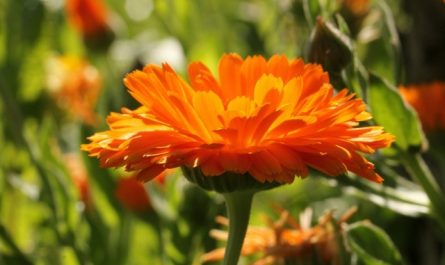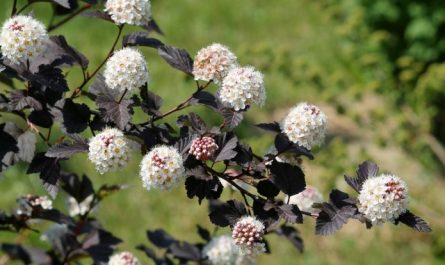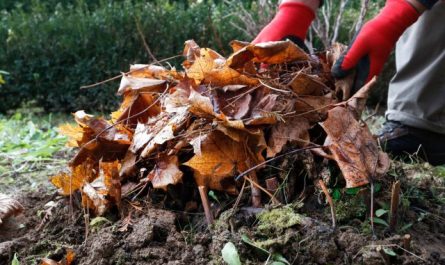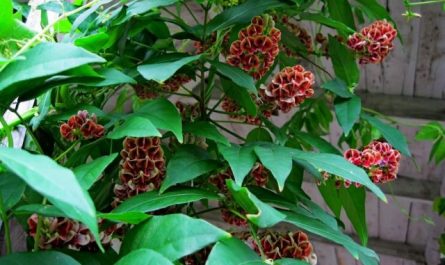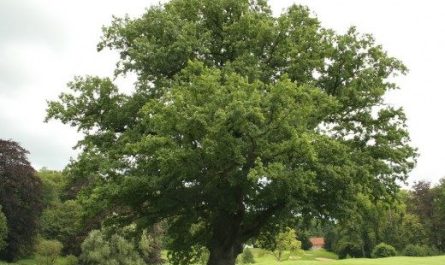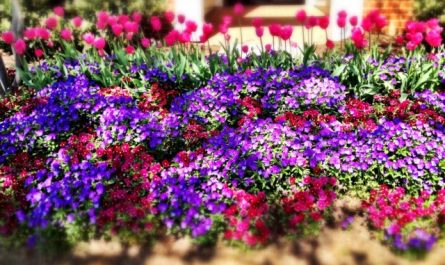Among the early and beautifully flowering cultivated plants, pansies occupy one of the first places in floriculture. The variety of their colors and color combinations is simply incredible: from pure white to almost black with all sorts of shades of yellow, blue, red. In the center of the flower there is often a spot of an original shape and color. In this article, we will tell you about the most popular types and varieties of pansies, and also share the experience of growing these beautiful flowers.

Description of the plant
There are two most popular species of this plant – Viola tricolor and Viola wittrockiana. They differ in the shape of the flower. Vitta wittrockiana has larger flowers, and Vitta tricoloriana is a small-flowered plant.
- Pansies, or Viola tricolor (Viola tricolor) is a herbaceous plant common in Europe and temperate regions of Asia; a species of the genus Violet of the Violet family.
- Viola wittrockiana, or garden pansies (Viola × wittrokiana) is a herbaceous plant of hybrid origin of the Violet family. This name unites numerous varieties and cultivar groups obtained with the participation of the wild pansy (Viola tricolor), Altai (Viola altaica) and yellow (Viola lutea) and some other species.
In ancient times, pansies were believed to have the ability to bewitch love: all you have to do is sprinkle the juice of the plant on the eyelids of a sleeping person and wait for him to wake up – he will love forever. The French and Poles give pansies as a keepsake when parting. And in England, a tradition was born: a young man who is embarrassed to declare his love, just sends his chosen one this dried flower and writes his name.
Pansies are perennial plants from 15 to 30 cm high, usually grown as biennials. Their spectacular flowers repeat the shape of a violet. The bushes are compact at the beginning of the growing season, then become spreading; the main shoot is erect, the root system is fibrous. In the leaf axils, pansies form peduncles, the ends of which are crowned with single large flowers up to 7 cm in diameter. The special value of pansies is their early and abundant flowering. In central Russia, they bloom already at the end of April.
Numerous varieties of large-flowered violets are common in culture – a complex hybrid obtained through many years of selection work. Many modern hybrids are resistant to heat and have the ability to bloom throughout the summer.


Cultivation and care
Pansies are used for early spring two-shift flower design. In summer, when it loses its decorative effect, it is replaced by annuals. But depending on the sowing dates and adopted agricultural technology, it is possible to obtain flowering in summer and late autumn. In this regard, pansies are a very flexible, undemanding and easy to cultivate plant.
Pansies are propagated mainly by seeds and green cuttings. Depending on the planned flowering period, sowing is done at different times. To obtain abundant early spring flowering, seeds are sown in the summer of the previous year.
In the northern and northwestern zones, for example, near Leningrad and in Murmansk, sowing of seeds in open ground (seedbeds) is done in the second ten days of July so that the plants do not develop too much, are not too large, and do not bloom in the fall.
Pansies are winter-hardy plants, but in the North-West, and sometimes in the middle zone, they freeze and rot. This often happens in damp places and when sowing dates are violated. If the seeds are sown in late May-early June, the seedlings bloom in the fall and outgrow. Such plants go into winter already weakened, they do not survive the winter well and rot more often.
Therefore, plants that have developed a good bushiness, but are not overgrown or weakened by autumn flowering, survive the winter better, do not rot, and bloom well in the spring of the following year. With later, belated sowing, the plants go into the winter not being strong enough, with little bushiness. They winter worse and bloom later in the spring.
Winters with little snow and severe frosts have a negative effect on the overwintering of pansies. Spring is especially destructive when the snow melts very early, thaws begin, and severe frosts occur at night. Therefore, it is advisable to retain snow on the beds with pansies. They do not tolerate low damp places and especially spring stagnation of water.

Propagation of pansies by seeds
To obtain seedlings, sowing is carried out in nurseries or on well-cultivated beds in rows, in a row the seeds are sown not densely, shoots appear on the 6-14th day. Care is usual: watering, loosening between the rows. The shoots are pricked out to other beds or nurseries, where they should winter. The distance during picking is 20×20 cm. Picking should be done in a timely manner, not allowing the seedlings to stretch out and outgrow.
The following year, early in the spring, the plants quickly begin to grow and bloom. To speed up the flowering, the beds can be covered with film in early spring. Pansies in bloom are transplanted into flower beds. To decorate windows and balconies, they are planted in pots or flower boxes.
Care for plantings in the design areas consists of systematic weeding and loosening. If necessary, watering and pest control are carried out. It is useful to feed seedlings with ammonium nitrate and add superphosphate (20-40 g per 1 m2). Pansies do not tolerate fresh manure. To prolong flowering in the summer, it is necessary to remove all faded flowers to delay the development of fruits, since when seeded, the plants stop flowering.
On poor, dry, sandy soils, pansies quickly become smaller, especially varieties with giant flowers. It is necessary to add organic fertilizers in the form of compost and humus (5 kg per 1 m2) to such soils; it is not recommended to add fresh manure. In a sunny place, pansies form large and bright flowers. In partial shade, they bloom a little longer, but poorer, the flowers are smaller and not so bright.
In the summer, when pansies fade and lose their decorative properties, they are dug up and replaced with annuals.
To obtain seeds, the most typical strong compact specimens are selected from the dug-up plants and planted in seed beds (they easily tolerate transplantation in the flowering state). Watering is necessary.
Considering that pansies are cross-pollinating plants, when planting them for seeds, it is necessary to observe spatial isolation of one variety from another. This will allow you to get purebred seeds. Seed collection should begin when the boxes turn yellow, otherwise they quickly crack and the seeds spill out.
If desired, pansies can be grown as an annual crop. For this, seeds are sown in February-March in a greenhouse or room in bowls, picking boxes. In April, they are picked into hotbeds, and in May, they are planted in the ground. When sown in spring, pansies bloom for a long time in the summer of the same year. But in terms of the abundance and size of flowers, the annual crop is much inferior to plants grown from last year’s summer sowing.
For autumn flowering, pansies are sown in April-May; they bloom on the 55th-70th day.

Vegetative reproduction
Of great interest is the vegetative method of propagating hybrid varieties of pansies – green cuttings in open ground. It is simple, effective and at the same time allows you to keep the variety pure, get a lot of planting material in one summer. Cuttings are taken from May to July in 2-3 stages. All green terminal shoots with 2-3 nodes are suitable. For this, low ridges are made in shaded, slightly damp places (under the canopy of trees). They are tightly tamped and watered.
The cuttings are planted at a depth of 0,5 cm tightly, so that the leaves of one cutting touch the leaves of another. 400 pieces are planted per square meter. After planting, spray with water.
In the first days, to avoid wilting, the planted cuttings should be covered with paper soaked in water, creating a more humid atmosphere, which promotes rapid rooting. Care consists of daily watering, spraying, weeding. In 3-4 weeks, the cuttings give 95-100% rooting. With early (May, June) cuttings, the plants bloom in the summer or fall of the same year. Later cuttings give abundant flowering in the spring of the following year.
Rooted cuttings are transplanted in the fall to beds or flower beds. In case of very late cuttings (August), it is better to leave the rooted plants for wintering in the places of cuttings, covering them with a sheet for the winter. Plants should be planted in flower beds in the spring of the following year.
Reproduction of hybrid pansies by green cuttings ensures rejuvenation of plants, which tend to grow strongly in the third year to the detriment of flowering. About 10 cuttings can be cut from one mother plant at one time, and 30-45 pieces over the summer.
The best varieties of pansies
Small-flowered varieties
- “Blue Boy” — flowers are blue-light blue in color, 3-4 cm in diameter;
- “Snow Maiden” — flowers are white, 3-4 cm in diameter.
- “Little Red Riding Hood” — flowers are bright red, 3,5-4 cm in diameter.
Large-flowered varieties
- “Ice King” — the flower is white with a barely noticeable yellowish-green tint. On the lower three petals there are purple spots, the edges are smooth. The flower is on a long stem (8-10 cm), up to 5 cm in diameter. The height of the bush is 20 cm.
- “Winter Sun” — the flower is bright yellow, on the three lower petals there are dark velvety brown spots, the edges are uneven. The flower is on a long stem (8-10 cm), 5 cm in diameter. The height of the bush is 20 cm.
- “Heavenly Queen” — the color of the flower when it opens is almost pure blue, it fades in the sun and acquires a light lilac-blue hue. The flower reaches 4,5-5 cm in diameter. The edges of the petals are smooth, the peduncle is long — 9-11 cm. The height of the bush is 20 cm.
- “The Magic of March” — the flower is dark purple, almost black when fully open. The petals are velvety, the edges are smooth. The flower is 5-5,5 cm in diameter, the peduncle is long (9-10 cm). The height of the bush is 20 cm.
- “Jupiter” — the flower’s upper petals are purple-violet at the base, whitish at the top. The color of the three lower petals is also purple-violet, the edges of the petals are even, the peduncles are short (7-8 cm). The height of the bush is 20 cm.
- “Evening Heat” — the flower is brownish-red, on the lower three petals in comparison with the main background there are darker spots, the edges of the petals are slightly wavy, the peduncle is long (9-10 cm). The flower reaches 5-5,5 cm in diameter. The bush is low 10-15 cm.

Giant varieties
- “Blue” — the flower is violet-blue, on the three lower petals there are dark violet spots, the edges of the petals are smooth, the flower is 6-7 cm in diameter, on a long peduncle (10-11 cm). The height of the bush is 25 cm.
- “White” — the flower is white with a barely noticeable yellowish-greenish tint, reaches 6-7 cm in diameter, the edges of the petals are slightly wavy, the peduncle is long (9-10 cm). The bush is 20 cm high.
- “Golden Yellow” — the flower is single-colored, golden-yellow, reaches 6-7 cm in diameter, the edges of the petals are smooth, the peduncle is long (10-12 cm). The height of the bush is 20 cm.
Potential growing problems
Among pests, pansies can be affected by aphids and cutworms, against which appropriate preparations are used. Among diseases, if agricultural technology is violated, black leg, root and stem rot, spotting, and powdery mildew can develop.
Due to their unpretentiousness and abundant flowering, pansies are grown in flowerbeds and balcony boxes, decorate bulbous flower plantings and alpine slides. With proper care, they will delight you with their flowering from early spring to late autumn.
There is a legend that after many years of waiting, the faithful girl Anyuta turned into this flower, having once seen off her fiancé to defend his native land, who never returned. And now, as many years ago, pansies stand near the road, hopefully “peering” into the distance.
